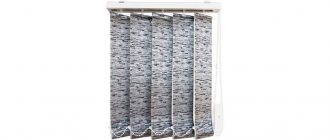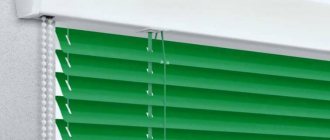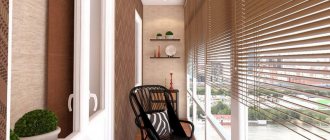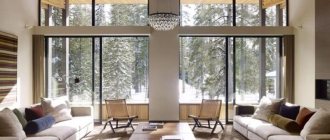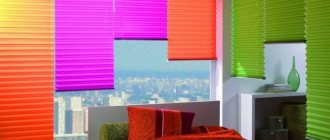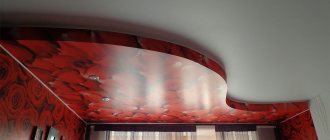Not so long ago, blinds were considered an indispensable attribute of offices and other public places, but that’s all. Boring colors and minimal design variations made them unattractive for home decor. However, everything has changed. New modifications are practical, functional and beautiful, so they are worthy of taking a place in any home. Let's look at what types of window blinds there are.
Two main groups of blinds
Based on the direction of the slats, blinds are divided into two main groups - horizontal and vertical.
Horizontal blinds
Horizontal models are more common - these are the usual blinds with horizontal slats, which look equally good at home, in offices, and public institutions. The standard width of horizontal lamellas is 16 and 25 mm. The canvases are made according to the width of the sash or the entire window, the standard length is 160 mm.
Vertical blinds
Vertical blinds are often made of fabric. They are installed on windows, in doorways or used in a room to zone space. As a rule, vertical slats are wider. The American standard for the width of vertical blinds is 89 mm and the European standard is 129 mm.
Both horizontal and vertical slats are connected to each other by a chain or rope. They carefully rotate around their axis and can be easily assembled, rising to the upper eaves. Systems are controlled manually or automatically. Due to the ability to rotate the slats at different angles, it is easy for the user to adjust the amount of light that the curtains allow into the room.
Vertical blinds are less deformed when heated by the sun, they are easier to operate, but horizontal models are cheaper. The price for vertical structures is higher because they need to additionally buy a mechanism along which the canvas will slide when opening. The direction of movement of vertically oriented slats can be from left to right, right to left or from the center to the sides.
What should you consider when purchasing?
Before you buy blinds in general and vertical blinds in particular, you need to decide how exactly you will hang them. There are several options here.
- Option one: blinds are attached to the window opening.
In this case, the room seems larger, but the window sill will be occupied by slats and your favorite flowers will have to be moved to another place - after all, the slats must turn freely.
- Option two: the blinds are attached with an overlap.
Most often - to the wall above the window (like a cornice for ordinary curtains) or to the ceiling.
Then the window opening is closed entirely and the flowers can be left on the window.
In any case, before purchasing, we advise you to carefully check whether flower pots (and other “foreign objects” on the window sills) will interfere with the opening and closing of the blinds and the rotation of the slats (window sill, radiators, etc.).
And further. The most important thing is when ordering blinds, correctly calculate their so-called overall dimensions. How to do it?
- First. If you decide to hang blinds inside a window opening, subtract two centimeters from the height of the opening so that the slats do not lie on the window sill.
- Second. If you want to attach blinds to the wall above the window, it is better that they are a little wider and extend about fifteen centimeters beyond the window.
- Third. The distance between the floor and the blinds must be at least 5 cm.
And one more important question that you need to decide on before placing an order - in which direction will the blinds open and close? There are four options for the movement of the slats when closing the blinds:
- the slats move in the direction opposite to the control rope;
- the slats move towards the control rope;
- the lamellas move in both directions from the center;
- the slats move towards the center.
Four options for the movement of the slats when closing the blinds. Keep in mind: the right choice is dictated not only by your tastes and preferences, but also by “production necessity.” For example, be sure to pay attention to whether the assembled slats will interfere when you want to open the window.
Well, these recommendations are perhaps the most important thing to choose the right vertical blinds. Having decided on the dimensions, installation and opening options, you can order. The order completion time depends on the volume and complexity of the work. But on average it takes a day.
Types of blinds according to the material used to make the slats
According to the material from which the slats are made, blinds are:
- Metal.
- Plastic.
- Wooden.
- Fabric.
Each type has pros and cons, but they are all characterized by aesthetics, practicality, and ease of care. To clean, simply wipe the slats from dust with a damp cloth and detergent.
Blinds made from certain materials are suitable for different rooms. In the kitchen, it is better to use aluminum or plastic blinds, provided that the latter are not located near the stove. Wooden structures look chic in living rooms, fabric ones in bedrooms. In wet rooms - bathrooms and showers - if they have windows, it is better to use waterproof plastic models.
Pros and cons of metal (aluminum) blinds
Metal blinds are made of aluminum. Aluminum structures are characterized by increased strength and durability. The slats can be oriented vertically or horizontally, matte or glossy, in a natural metallic color or painted in a range of RAL colors.
Metal blinds.
Advantages of aluminum blinds
- Temperature resistance. Unlike plastic models, metal ones can be installed near an open fire: in the kitchen near a gas stove, radiators, heating boilers.
- Do not fade under the influence of UV rays.
- Light weight. Aluminum structures are somewhat heavier than plastic or fabric ones, but nevertheless they are lightweight.
- They have good resistance to wind loads. When the windows are open, they retain their shape and do not flutter or flutter like lighter fabric or plastic products.
- Increased strength. Metal strips are convenient because they do not tear, break, or burn.
- Fire safety. Today this is an important factor for consumer goods, when the market is filled with synthetic materials that release toxic substances when burned.
- Easy to care for. The metal does not absorb grease and does not change its appearance during use. To clean, simply rinse the slats with water and ordinary detergents.
- Durability. When used correctly, they last longer than other types of blinds.
- Excellent aesthetic properties. Metal structures are relevant in interiors decorated in hi-tech, modern, and loft styles.
Cons of aluminum blinds
- Metal has high thermal conductivity, so window structures heat up in summer when exposed to direct sunlight.
- When there are strong gusts of wind, they produce a characteristic metallic knock when the slats hit each other.
Aluminum products meet sanitary and hygienic requirements, therefore they are widely used in medical institutions, clinics, and for decorating cafes and restaurants.
Advantages and disadvantages of plastic blinds
Plastic window blinds are made from PVC in white or painted in RAL colors. Plastic blinds are in demand by customers. They are practical, the color range is rich, and their price is low. Plastic blinds are cheap, so they can be replaced frequently.
Plastic blinds.
Advantages of plastic blinds
- They are inexpensive.
- Many colors. Manufacturers offer a huge number of canvas colors - calm pastel shades, bright colors, stylized like wood, metal, stone.
- Plastic is practical, hygienic, and easy to care for.
- Plastic slats are not afraid of moisture, so they are used in rooms with high humidity - saunas, bathrooms, shower rooms, toilets, and kitchens away from open fire.
- They serve for a long time without losing their appearance and do not deteriorate.
- Suitable for any interior - residential building, apartment, cottage or office.
- Pairs well with fabric curtains and tulle curtains.
Cons of plastic blinds
- Not resistant to heat. When strongly heated by the sun's rays in the summer heat, the plastic softens, the geometry of the canvas is disrupted, and the products lose their shape. Therefore, they cannot be installed near heat sources: stoves, ovens, radiators, fireplaces.
- Colored lamellas fade over time in the sun, white ones turn yellow over time.
- Plastic is more fragile compared to other materials; the lamellas bend and sometimes break. If there are animals in the house, they can chew through thin plates.
Despite some disadvantages, this is the most suitable type of blinds for plastic windows. The plastic option is suitable for an office, temporary housing or bachelor's apartment. Plastic products are inexpensive, easy to care for, and can be easily replaced when you get tired of them or break down. The designs are organically combined with fabric curtains and look neat without them.
Advantages and disadvantages of wooden blinds
Wooden blinds are often made from exotic woods - bamboo, balsa wood, Canadian linden. Natural material is more expensive, so prices are higher. Wood creates a special atmosphere in the house. This is a natural material, its presence in the interior is considered a sign of the owners’ good taste, high status, and respectability. The slats of wooden blinds are made of light species - bamboo, cork.
Wooden blinds.
Advantages of wooden blinds
- These are environmentally friendly designs that do not cause allergic reactions and do not emit harmful fumes.
- Wood is a beautiful and prestigious natural material. It gives the room a respectable appearance and solidity.
- They do their job well, protecting rooms from sunlight.
- Unlike metal structures, wooden ones do not overheat when exposed to direct sunlight.
- The lamellas have increased strength and dimensional stability.
- Wood planks are durable. The service life of wood is much longer than that of plastic models.
- Easy to care for. There are special devices for manual cleaning of slats.
- Wood has a low thermal conductivity coefficient, so wooden structures are warm to the touch.
- They look great in the interior, combined with furniture, especially solid wood.
Cons of wooden blinds
- Non-moisture resistant. The lamellas swell under the influence of moisture and water.
- Prices for wooden models are high.
New types of wooden structures made from valuable wood species are constantly appearing on the market.
Pros and cons of fabric blinds
They are made from fabrics with impregnations that repel dirt, dust, and water. They are easy to clean, inexpensive, and create comfort in the home. Fabric blinds only come with vertical slats. More often, slats are made of synthetic fabrics impregnated with water-repellent compounds - polyester or fiberglass. Sometimes cotton, jacquard, linen, and viscose are used to make them.
Fabric blinds.
Pros of fabric blinds
- Create comfort in the room. Fabric is a traditional material for window decoration, so fabric curtains are well received by residents and guests.
- Light in weight, unlike metal or wooden structures.
- They are easy to care for due to the presence of dirt-repellent impregnations in the fabric.
Cons of fabric blinds
- Compared to wood, plastic or aluminum systems, they are less durable.
- Due to their light weight, they are blown by the wind when the windows are open - the canvas “quivers”.
- The color variety is less than that of plastic structures, although quite large.
The fabrics vary in color and texture. Fabric blinds are more suitable for living rooms, bedrooms, studios, and dining rooms, but they are less often used in kitchens. The standard height of fabric slats is 180 cm, they can be shortened to fit the height of the window. To change the length of the strip, just remove the weighting material from the lower end and cut the fabric. Then you need to make a pocket at the bottom where you can insert the weighting material.
Combination ideas
Slats also have many successful combinations with other types of curtains; such combinations require special experience in interior design, so you should carefully use this decorative technique.
Tulle curtains will smooth out the strict appearance of the blinds and add aesthetics to the window design.
The combination of blinds with linen or cotton curtains is a win-win option in interior design, because it gives the window a more cozy look.
The photo shows pleated blinds in combination with dark curtains in the living room.
Horizontal slats in combination with a rigid lambrequin will look very harmonious.
The photo shows a dining room and horizontal slats in combination with a rigid gang lambrequin.
Types of blinds by color
White blinds
Light-colored blinds are widely used in residential buildings, offices, and public buildings. This is a universal color that goes harmoniously with all others.
Colored blinds
Plastic and aluminum slats can be painted in any color according to the international RAL scale. A wide selection of colors allows you to choose products that match tone-on-tone with the color of the walls or, conversely, make them contrasting.
Combined blinds
Combining horizontal blinds is done by using slats of different colors. As a result of combining 2–3 or more colors in one canvas, lively and original compositions are obtained.
Examples of combined horizontal blinds:
Combining vertical blinds can be done either by using slats of different colors, or by gluing fabrics of different colors, resulting in a two- or three-color slats.
Examples of combined vertical blinds:
Blinds with photo printing
Photo printing can be applied to plastic or fabric slats. Photo printing can be graphic (1-2 colors) or multi-color.
Examples of vertical blinds with photo printing:
Examples of horizontal blinds with photo printing:
When selecting blinds to match the color of the walls, ceiling or other structural part of the room, experts recommend choosing products that are two or three shades brighter or darker. In this case, they do not merge with the plane of the walls, they look natural, and the interior comes to life.
A contrasting color is chosen if the entire decor is in one shade - light or dark. If many different colors are used in the interior decoration, then it is better to choose window shading structures that match the color of the main one.
If you have difficulty choosing a color scheme, then the sure-fire option is white. White blinds will always go well with wall decoration and furniture texture.
Color palette
Certain colors create a unique design and give the room the necessary lightness, freshness or depth.
Red or burgundy slats look strict and respectable, but at the same time add brightness and personality to the room.
The photo shows red horizontal slats in the interior of a nursery.
A room with brown slats creates a solid and noble, but very cozy interior.
Green is a major favorite in modern design. Green slats give the room an attractive and expressive look.
The photo shows a living room and bright vertical slats in green.
Blue looks fresh and stylish. Blue or light blue blinds create a soft, delicate, but at the same time deep interior.
Yellow is cheerful and bright. This sunny shade gives the room warmth and light.
The photo shows a kitchen with a door and window opening decorated with yellow pleated blinds.
Golden color belongs to a warm color scheme, so it adds even more space and light to the room.
Orange brings dynamism to the interior of the room and creates a sensual, carefree and cheerful atmosphere in it.
The photo shows orange vertical blinds in the dining room interior.
White planks look very expressive and stylish, and make the light penetrating through them even brighter.
The stylish black color adds a touch of piquancy to the interior; such blinds look very strict and ascetic and create a monolithic design.
Beige is an enveloping and relaxing color; it calms and creates a favorable atmosphere in the room.
Elegant gray designs do not distract attention and blend harmoniously with the overall background of the room.
The photo shows window openings with gray pleated blinds in the interior of the office.
Pink shades create a particularly elegant and delicate interior.
The photo shows pink vertical blinds in a girl’s nursery.
Blinds by slat type
Depending on the slats used, the following types of blinds are distinguished:
- Undulating, or “wave”.
- Perforated.
- Multi-texture blinds.
Wave
The slats of these models have edges with wavy curves, in contrast to rectangular slats. Wave blinds are a relatively new product on the market. They are made of aluminum and can be horizontal or vertical. The wavy shape of the planks creates a whimsical play of light and shadow in the room, which increases the attractiveness of the product.
The unusual shape of the lamellas allows you to enliven the interior, add coziness to it, and get rid of excessive severity and coldness of the metal. Such designs are often used for the bedroom and living room. Refusal of rectangular shapes allows designers to create a special mood in the room.
Examples of vertical blinds with waves:
Examples of horizontal blinds with waves
With perforated slats
There are many small holes along the entire plane of the lamellas. More often, holes are punched evenly, at the same distance from one another, sometimes creating a graphic design or geometric pattern on the canvas. Perforated structures are made of aluminum and can be horizontal or vertical.
Perforation allows light to pass through even through a closed canvas; diffused sunlight penetrates the room, creating a pleasant, calm atmosphere. During the day, when closed, perforated curtains will protect people in the room from the sun without completely blocking the light flux.
Multi-texture blinds
These are vertical blinds whose slats are made of different materials, the length of which varies, creating an original pattern. Multi-texture blinds are an attempt by designers to avoid standard geometric shapes of the canvas. They combine the beauty of curtains with the functionality of blinds. To produce one model, different materials can be used: fabric, plastic, aluminum, which are combined in length and color.
Combining materials creates various patterns - wavy flounces, lambrequins in the form of arches, zigzags. Multi-textured blinds can transform any room, but they are especially appropriate in a classic-style kitchen. The practical, functional, easy-to-maintain design is stylized as curtains and looks luxurious.
Why are they so popular?
The microclimate in the room largely depends on the weather outside. The bright sun can literally heat up a room in minutes, raising the temperature to uncomfortable levels. This is especially noticeable in the summer, when there is nowhere to hide from the heat. Once upon a time, curtains were the only salvation from bright rays. But today there are slat systems that are more functional. Their strengths include:
- Possibility of adjusting the intensity of the light flux.
- Light weight and compact.
- Easy to use and maintain.
- Good selection of different variations.
Regardless of the type of system, they protect the room not only from the sun, but also from drafts, as well as from overly prying eyes.
Instagram dekorokon.kz
Blinds make it possible to effectively regulate the intensity of light entering the room
- Window
How to close windows from the sun: 4 simple options
Special types of blinds
In addition to traditional types of blinds for standard window or door openings, special designs are produced:
- Arched.
- Interframe.
- Electrically driven. Allows you to automate the management process. The canvas is opened and closed by the user at a distance.
Arched blinds
These are blinds for windows of a non-standard semicircular shape. Arched structures come with horizontal or vertical lamellas. Arched blinds will help out homeowners who have installed non-standard round-top windows in their homes. They are made to order according to window sizes. For arched structures installed above a window or doorway, you need a special semicircular cornice.
Interframe structures
Inter-frame blinds are built between the glass panes at the production stage of the double-glazed window. As a result, the user receives a light filter protected by glass from dust. Blinds installed between the glass are inaccessible to children and animals, so they last longer. In addition, these inter-frame models go well with traditional curtains, tulle, and drapes, as they do not interfere with the movement of fabric curtains along the window. Some manufacturers include cassette models that are fixed to the sash as inter-frame types of blinds.
Electric models
You can install an electric drive made in China or Europe to automate the process of opening/closing blinds on any window. The system can be controlled remotely (radio-controlled) or wired. The operating voltage of the equipment set is standard 220V or safe 12V. Automatic control is especially convenient if the windows are large, non-standard or attic, installed at an angle.
In addition to the usual wired and remote control systems, automatic ones have appeared on the market today. They have sensors to determine the amount of light flux. The systems open or close the blinds independently depending on the level of illumination in the room. Such models are used in smart home systems.
If you notice an error, a non-working video or link, please select a piece of text and press Ctrl+Enter .
0
Control methods
There are several options for lowering or raising your blinds.
- Mechanical. The most common way. Adjustment is carried out by a cord, chain, or control knob.
- With electric drive (automatic). This involves the movement of the structure using a special control panel, which at a distance allows you to lower, raise, move the slats to the side or even change their angle of position.
Original and unusual concepts
Even against the backdrop of all the variety of types of blinds, there are undoubted winners in the “originality” category.
Pleated curtains
This primarily applies to pleated curtains. Pleating makes it possible to implement bold design solutions with a constant level of sun protection properties. When force is applied to the control cord, the curtain forms folds and, thanks to the small mounting profile, becomes almost invisible against the background of the window.
A wide variety of designs and installation options allows you to use the following curtains:
- on glazed loggias;
- on glass ceilings;
- on arched windows;
- on the pyramids;
- on skylights and tilting windows.
Pleated curtains have a spring control mechanism that replaces a conventional cord. It is controlled using a rail, which, by moving, fixes the curtain in the desired position.
Cord and spring control mechanisms do not exhaust the possibilities of pleated windows when installed on roof windows. For windows located at high altitudes, control using a special rod is used. The limitation on the glass tilt angle of 30 degrees is critical only for the chain mechanism; there are no restrictions for the spring mechanism.
Bamboo blinds
The texture characteristic of bamboo, color and strength make blinds made from this natural material not only fashionable, but also durable and practical. Only from bamboo can you create unique eclectic interiors in an oriental style.
Distinctive features of bamboo blinds:
- ease,
- strength,
- moisture resistance.
The strips are assembled from straw and natural bamboo, and fastened with various types of weaving. The maximum width and height are 180 cm and 300 cm, respectively. Control can be either manual or automatic.
Japanese panels
Japanese panels, which are not yet widely used, but are rapidly gaining popularity, are considered the latest innovation on the market. They can combine different types of fabrics. The fabric pattern should not be hidden by folds, but should remain visible.
Japanese panels are characterized by minimalism and restraint. They can be equipped with a control mechanism and sometimes play the role of a screen.
Design
Here it is important not to overdo it or overload the interior. If you listen to our recommendations, you will be able to maintain a balance:
- the most universal color is white;
- models that are a couple of tones different from the color of the walls or furniture will look good;
- a contrasting shade or active pattern is suitable if you decide to focus attention on the window;
- black samples are appropriate in a minimalist interior, where the rest of the furnishings are white;
- in small rooms, light colors look great, visually expanding the space;
- if your apartment faces south, it is better to purchase curtains of a color that will help “cool” the atmosphere in the apartment: blue, green, turquoise, purple, and so on;
- peach, yellow, orange and brown shades can add comfort and warmth to the north side;
- The more spacious the room and the larger the window opening, the wider the slats can be.
To decorate fabric models, silk embroidery, gold or silver thread, ornaments, beads and beads are used.
Installation
It is better to leave the installation of blinds with drilling to specialists in this field. They will handle this without fail and in a short time.
But there is a simpler option that even a beginner can handle - installing blinds without drilling. In this case, you will not have to make through holes in the window frame.
But this method is only possible for installation on opening doors. It consists in the use of plastic fasteners. They are hung on brackets that are placed on top of the frame.
To prevent their accidental displacement, they are fixed on the reverse side with double-sided tape. Such L-shaped plastic brackets are not included with the purchase, but they can be easily found in a store that sells blinds and window accessories. This method is convenient in that it is possible to easily dismantle the blinds if repairs or thorough cleaning are required.
Rolled
Fabric roller blinds are the only fabric that is attached to a shaft. They are also called roller blinds. They can be installed in two systems: with a single piece of fabric (mini) or with alternating stripes (zebra mini).
Wooden
Advantages:
- creating coziness, especially a comfortable atmosphere;
- a wide range of textures, colors and patterns;
- high strength.
Flaws:
- natural wooden blinds have a beige-brown color;
- poor resistance to strong humidity;
- the price is completely undemocratic.
Curtains in rolls
Roller blinds, despite their long history, have not become widespread until now. Historically, their use was determined by the inability to use blinds for aesthetic reasons.
Now, according to PROMA specialists, the situation has changed. This was due to a number of factors:
- improvement of management mechanisms;
- variety of types of fabrics and expanding the range of their properties.
Advantages of roller blinds
Roller blinds are rightfully considered one of the most practical ways to decorate windows. Selecting fabric with the desired transparency and ease of folding to the desired length allows you to obtain soft diffused light and very flexibly adjust the level of illumination in the living room, nursery or bedroom. Due to their design features, they can be placed in confined spaces and in conditions where the use of curtains is impossible: loggias or a window in the kitchen, as well as in a window opening, wall or ceiling.
For the sunny side, it is recommended to use sun-reflective fabrics. They do not fade or change color. The main advantages of roller blinds are maximum sun protection, ease of use and the ability to get a seamless pattern when decorating windows. Roller blinds are practically indispensable when organizing a home cinema.
Internal organization
The operating principle of roller blinds is obvious - the canvas is rolled up and unrolled using a chain mechanism. Restrictions on the maximum width of the product are 2.02 m. The PROMA company is ready to offer a full range of fabrics for roller blinds with all possible properties: from translucent to blackout.
Care and cleaning
When washing windows, roller blinds should be rolled into a roll, so the fabric will be protected from detergents or dirt. You can wash such fabric with a sponge using a powder with PH=7, that is, neutral. Rolled fabric should be dried unrolled and under no circumstances wrung out. Stains can be removed using natural stain removers or dry cleaning services.
Placement in cassette
There is a subtype of roller blinds called “cassette”. They were specially designed for plastic windows and euro-windows made of wood. However, they can also be installed on regular tilt-and-turn windows. A compact, strict-looking box with fabric wound inside harmonizes perfectly with modern high-tech windows. Convenient side guides almost completely block light when using blackout fabrics.
Pleated
The canvas, assembled into an accordion, looks compact, elegant, fits into most interiors and is at the same time unpretentious in care. The structure is installed on the glass itself or on the frame; it can be used as an interior door if placed in the opening.

